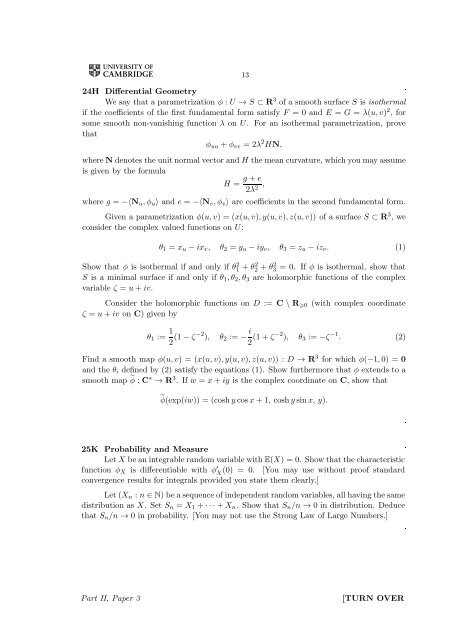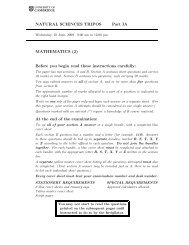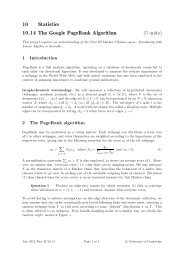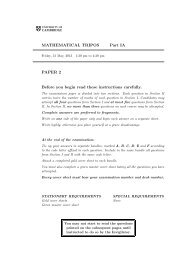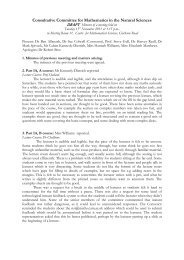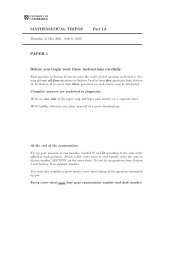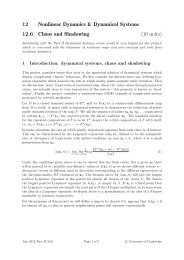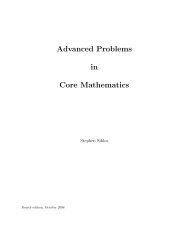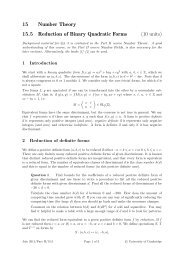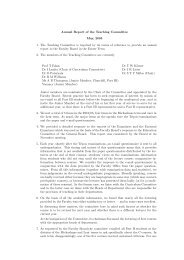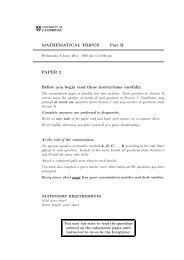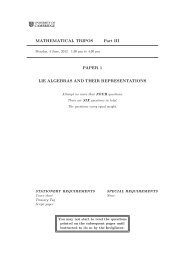MATHEMATICAL TRIPOS Part II PAPER 3 Before you begin read ...
MATHEMATICAL TRIPOS Part II PAPER 3 Before you begin read ...
MATHEMATICAL TRIPOS Part II PAPER 3 Before you begin read ...
- No tags were found...
Create successful ePaper yourself
Turn your PDF publications into a flip-book with our unique Google optimized e-Paper software.
1324H Differential GeometryWe say that a parametrization φ : U → S ⊂ R 3 of a smooth surface S is isothermalif the coefficients of the first fundamental form satisfy F = 0 and E = G = λ(u, v) 2 , forsome smooth non-vanishing function λ on U. For an isothermal parametrization, provethatφ uu + φ vv = 2λ 2 HN,where N denotes the unit normal vector and H the mean curvature, which <strong>you</strong> may assumeis given by the formulaH = g + e2λ 2 ,where g = −〈N u , φ u 〉 and e = −〈N v , φ v 〉 are coefficients in the second fundamental form.Given a parametrization φ(u, v) = (x(u, v), y(u, v), z(u, v)) of a surface S ⊂ R 3 , weconsider the complex valued functions on U:θ 1 = x u − ix v , θ 2 = y u − iy v , θ 3 = z u − iz v . (1)Show that φ is isothermal if and only if θ1 2 + θ2 2 + θ2 3 = 0. If φ is isothermal, show thatS is a minimal surface if and only if θ 1 , θ 2 , θ 3 are holomorphic functions of the complexvariable ζ = u + iv.Consider the holomorphic functions on D := C \ R 0 (with complex coordinateζ = u + iv on C) given byθ 1 := 1 2 (1 − ζ−2 ), θ 2 := − i 2 (1 + ζ−2 ), θ 3 := −ζ −1 . (2)Find a smooth map φ(u, v) = (x(u, v), y(u, v), z(u, v)) : D → R 3 for which φ(−1, 0) = 0and the θ i defined by (2) satisfy the equations (1). Show furthermore that φ extends to asmooth map ˜φ : C ∗ → R 3 . If w = x + iy is the complex coordinate on C, show that˜φ(exp(iw)) = (cosh y cos x + 1, cosh y sin x, y).25K Probability and MeasureLet X be an integrable random variable with E(X) = 0. Show that the characteristicfunction φ X is differentiable with φ ′ X(0) = 0. [You may use without proof standardconvergence results for integrals provided <strong>you</strong> state them clearly.]Let (X n : n ∈ N) be a sequence of independent random variables, all having the samedistribution as X. Set S n = X 1 + · · · + X n . Show that S n /n → 0 in distribution. Deducethat S n /n → 0 in probability. [You may not use the Strong Law of Large Numbers.]<strong>Part</strong> <strong>II</strong>, Paper 3[TURN OVER


